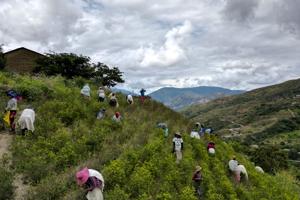TRINIDAD PAMPA, Bolivia — If it were anywhere else in South America, the nondescript house with buckets of coca leaves soaking in liquid could be mistaken for a clandestine cocaine lab. Farmers harvest coca leaves in Los Yungas on April 14 along the outskirts of Trinidad Pampa, a coca-producing area of Bolivia. But this is La Paz, Bolivia, and the fruity aroma of coca steeping in barrels signals that you've arrived at the government-authorized El Viejo Roble distillery, which for years has been making liquor from coca leaves and is now gearing up to launch a coca-infused beer.
It remains questionable whether Bolivia can persuade the world to accept the hardy green leaf best known beyond its borders as the main ingredient of cocaine. But a recent landmark decision by the World Health Organization to study coca's non-narcotic benefits has rekindled the old hopes of Bolivian farmers, makers and sellers. “Exporting is a desire that my people and I have had since I was a child,” said Lizzette Torrez, leader of one of Bolivia's main coca-grower unions.

Within Bolivia, the world’s third-biggest producer of the coca leaf, and of cocaine, the ancient leaf has inspired spiritual rituals among Indigenous communities for generations — and more recently, among the well-heeled, a deluge of coca-related products, including El Viejo Roble’s new star $2 brew. “Beer can be bitter, but with the sweet touch that we give it with coca makes it is more palatable,” manager Adrián A.























